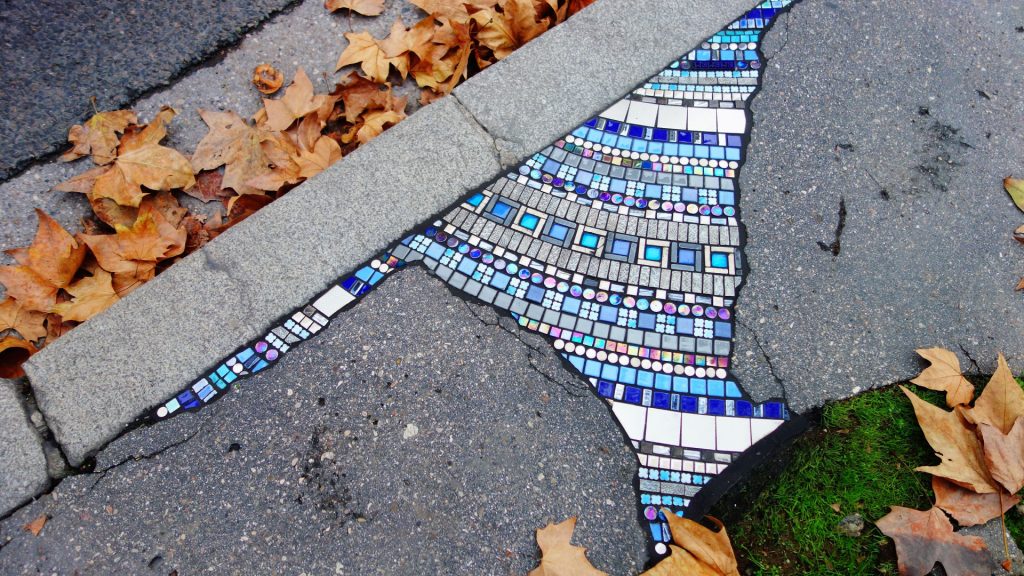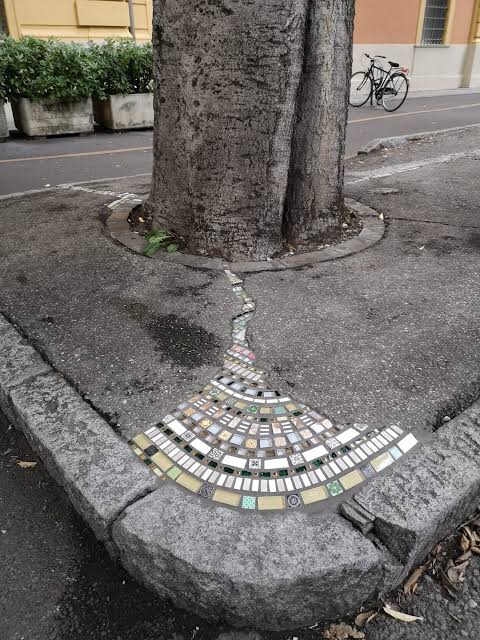by Hazel Anna Rogers for the Carl Kruse Arts Blog
It is dawn, and the city is not awake, because in France, cities sleep when the night rolls through them. Maybe a light shines out from the backroom of a bakery, where a few bakers with sleep in their eyes pound and shape dough beside a firing stone oven so the breads will be baked in time for the morning traffic when it streams in through the bakery doors. Perhaps a waitress is walking dozily beside the flowing grey of the Rhône with the keys to her café jangling between her front two fingers. And somewhere, perhaps, there is a shadowy figure retreating unseen from a wide crack in the pavement, which he has filled with tiny shards of ceramics that glitter like stars as the sun glares up, up and above the towering white of the Cathédrale Saint-Jean-Baptiste. The day has begun, and there is a new artwork by Ememem in the streets of Lyon.
Ememem is an anonymous artist, described by Ian Phillips of The Guardian as ‘France’s answer to Banksy’, and has produced over 350 artworks throughout the streets of Lyon; from potholes to pavements, from gaps beside wide gnarled tree roots to broking paving stones, Ememem’s ‘flacking’ (his name for the mosaic method he uses) shines through the gaps in the cityscape.
Ememem’s work seems, to me, a sort of variation on Kintsugi, the Japanese art of traditional ceramic repair, a way to visualise the mending process of broken ornaments which treats breakages as essential in the history and future of an object, rather than as something to be seamlessly hidden. The imperfections of these objects are highlighted and cherished using Kintsugi, as the cracks in the concrete of Lyon are highlighted and made colourful by Ememem.
The word ‘flacking’, which Ememem uses to describe their technique, is a neologism originating from the French word ‘flaque’, meaning puddle. I think this to be a most poetic way to describe Ememem’s artwork. As puddles of colour, with patterns pooling out from their centres and dribbling into the surrounding splits, just as water would. As natural as rain, Ememem’s works blend into the metropolis.

There are many roadworks occurring in my city at the moment. Holes in the road being filled with steaming concrete. Paving stones being unearthed from their soft cement beds and replaced by other such stones. Small potholes being haphazardly filled in – when they dry up, they make little molehills in the road. And all around these works is commotion. Trucks, huge machinery buzzing and whirring and crackling, men in neon waving this way and that, or bent over, tugging at rocks and earth, or stood observing as a mechanical arm picks up grey detritus before them. It is not that these works are not essential, of course not. But perhaps there are some instances where an Ememem-type figure could perform their quiet work, and calm the noise somewhat; maybe they might venture out from the woodwork in the dead of night, and fill in the deep crevasse that has emerged on the pavement over by that café, fill it with red circles and blue squares and orange crescents and green rectangles, fill it with colour and brightness and precision and beauty. It would be good, I think, if we were to fill in the holes of this city with more colour.
I like to imagine how Ememem might create one of their artworks. How patiently they must place the little pieces of ceramic, how very meticulously they must plan out the pattern in order to fit it exactly into the strange shape that has been gouged out of the street, or road, or wall. How quickly they must work so as not to be seen by a soul.

Not a lot is known about Ememem, but there have been musings about the reason behind their name; their agent of 15+ years, Guillaume Abou, asserts it may be a reference to the first letters from Lou Reed’s ‘worst’ album – Metal Machine Music (from The Guardian article entitled ‘France’s answer to Banksy: the anonymous street artist filling potholes with colourful mosaics’ – September 2022). Ememem have purportedly said that their name refers to the sound made by their moped when they go out at night to create their pieces (I challenge you not to make that noise in your head). I’m not sure which idea I prefer – Lou Reed or the rumbling of a moped grumbling reluctantly awake at midnight. We know that Ememem is French, though speaks with a bit of an accent (perhaps Italian, suggests Ian Phillips of The Guardian), and that they are untrained, artistically speaking, though their father was a house tiler. Might that make Ememem a street tiler? I’ve always thought it to be a wonderful thing to follow in one’s parent’s footsteps, to learn a craft from them and continue it on for generations. It is a lost thing, I think. These days, we find our own way, and reject the old ways of our parents in favour of paving a path towards the new. Always pushing forwards, quicker, faster. Never taking a moment to admire the path from whence we came, or taking the time to fill in the cracks in that path with our own mosaics. Rather, we move to different streets, different roads, and leave the old to whither in our wake.
It is refreshing to have an artist without a face. Anonymous authorship is not a particularly easy feat in the modern day, and, save for the aforementioned Banksy, I can’t think of any other known artists who have managed to successfully make themselves opaque to the public’s ever prying eyes. We live in a visual age, an age where parasocial relationships have become the norm. We believe that we KNOW our favourite celebrities, or ‘artists’ – we know what they eat, we know the music they like, we know who they’re married to or dating, what clothes they wear, where they live, where they grew up, what school they went to, who their friends are…and, perhaps, we might feel that they know us, in some way, or that they might be our friends, should we meet them in real life. So, to have an artist who rejects all that, who is known only for the patterns they’ve made in the cracks in a city, is quite magnificent. Ememem ‘fixes’ the city, makes it beautiful, and they do not even want us to know their name. This, to me, implies a humility and compassion that I do not think I possess as an artist, nor ever will.
==============
The Carl Kruse Arts blog homepage.
Contact: carl AT carlkruse DOT com
Other articles by Hazel include: Giorgio Morandi, Art for Arts Sake, and Single Mums.
Also find Carl Kruse at Kruse on Crunchbase am on an older blog at https://carlkruseofficial.blogspot.com/